Financial Accounting: IAS 38 Report for Technology Enterprises Ltd.
VerifiedAdded on 2022/12/30
|10
|2674
|65
Report
AI Summary
This report provides an analysis of financial accounting based on IAS 38, focusing on intangible assets and their valuation within Technology Enterprises Ltd. The report begins with an introduction to intangible assets and their significance, followed by an examination of how the company accounts for its R&D project and patent in the financial statements, adhering to AASB 138. It emphasizes the importance of valuing assets at their acquisition cost and highlights the company's ability to value intangible assets at fair value. The report addresses the senior management's concerns regarding the accountant's valuation practices and concludes with a response to the CEO, discussing the application of AASB 138 and the efficient market hypothesis. The analysis covers the company's choices in reporting intangible assets, the correct application of accounting standards, and the impact of valuation on financial statements and stakeholder decisions. The report emphasizes the importance of proper disclosure and the use of fair market values to ensure reliable and relevant financial reporting, which can lead to increased shareholder value.
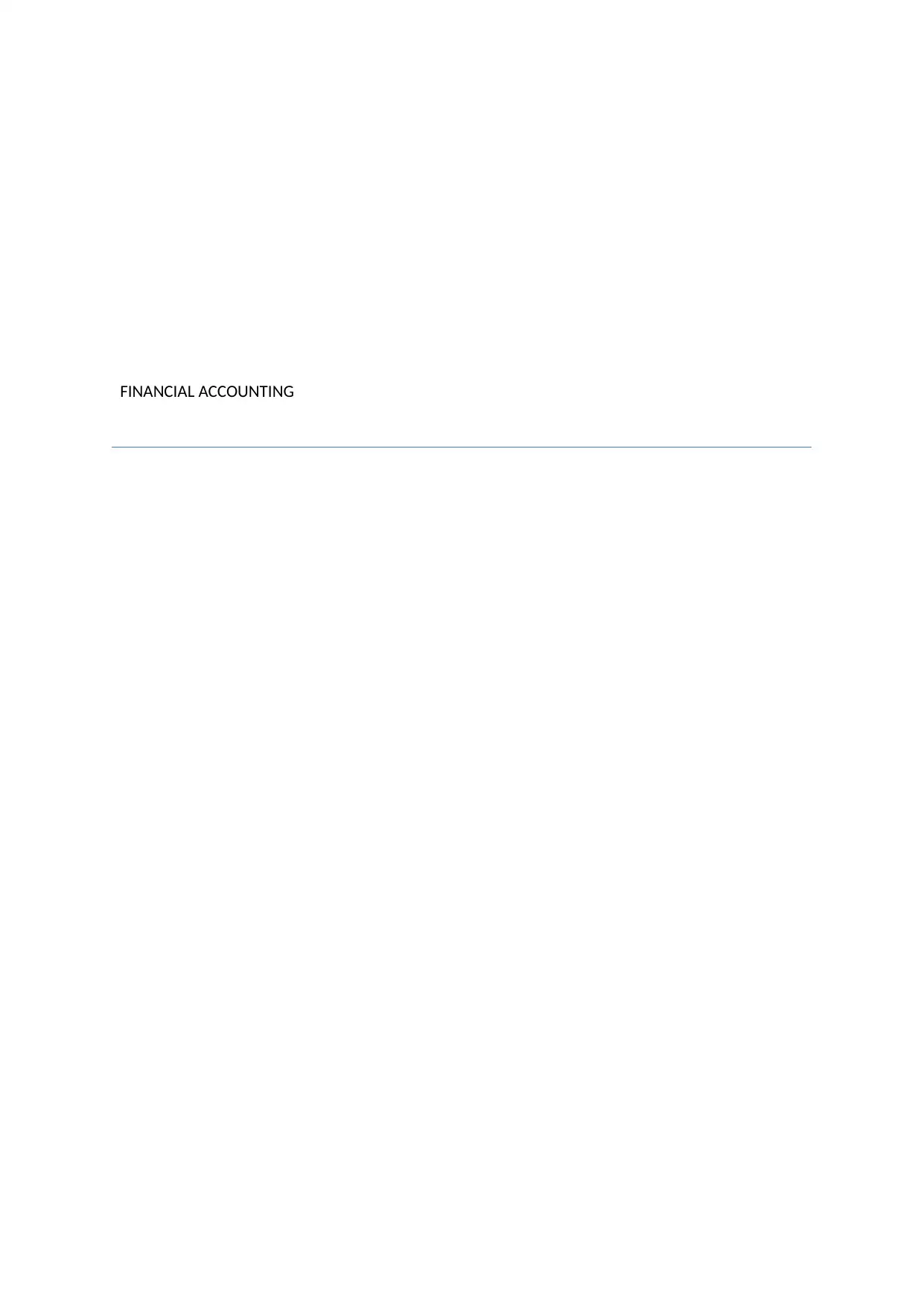
FINANCIAL ACCOUNTING
Paraphrase This Document
Need a fresh take? Get an instant paraphrase of this document with our AI Paraphraser
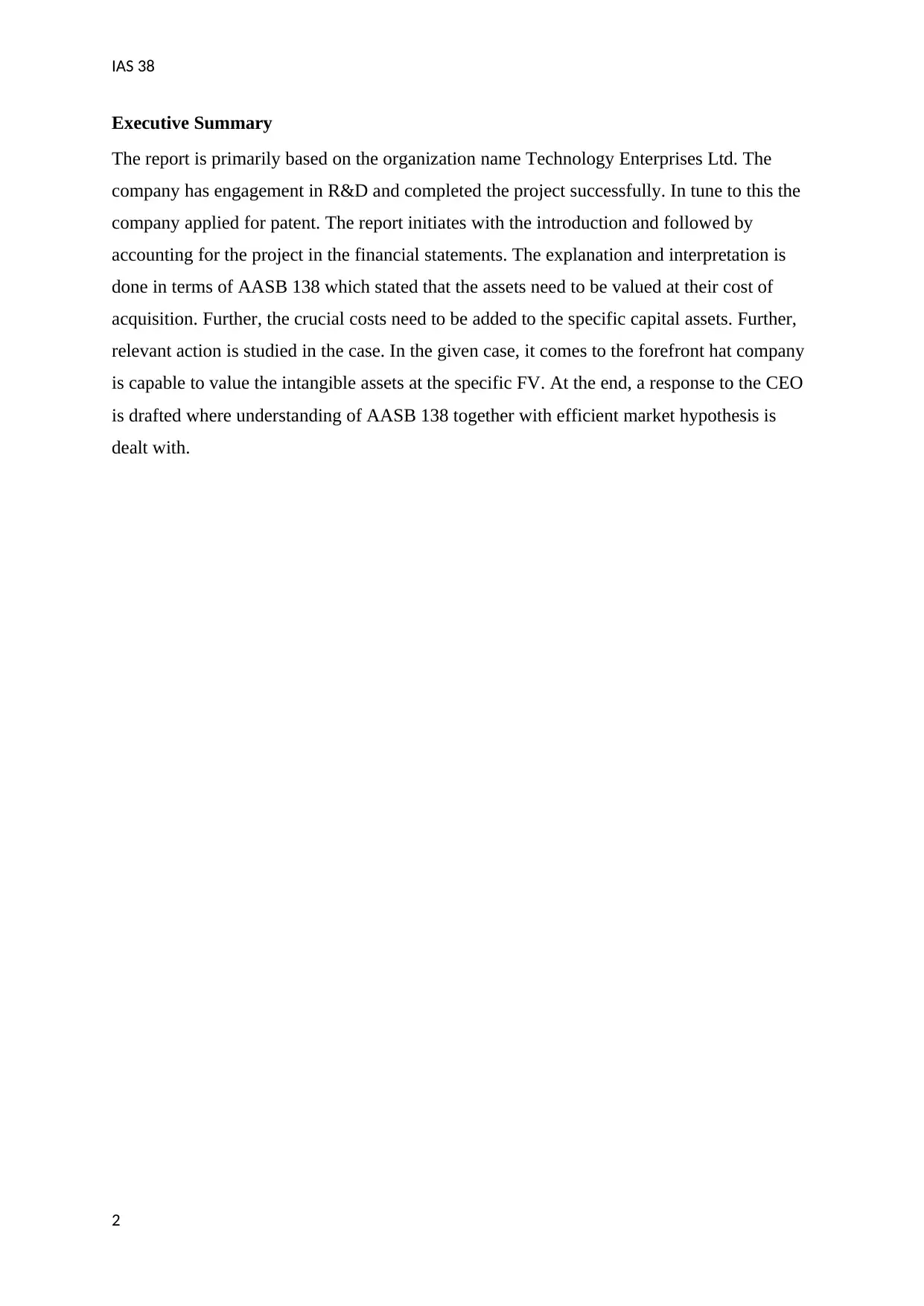
IAS 38
Executive Summary
The report is primarily based on the organization name Technology Enterprises Ltd. The
company has engagement in R&D and completed the project successfully. In tune to this the
company applied for patent. The report initiates with the introduction and followed by
accounting for the project in the financial statements. The explanation and interpretation is
done in terms of AASB 138 which stated that the assets need to be valued at their cost of
acquisition. Further, the crucial costs need to be added to the specific capital assets. Further,
relevant action is studied in the case. In the given case, it comes to the forefront hat company
is capable to value the intangible assets at the specific FV. At the end, a response to the CEO
is drafted where understanding of AASB 138 together with efficient market hypothesis is
dealt with.
2
Executive Summary
The report is primarily based on the organization name Technology Enterprises Ltd. The
company has engagement in R&D and completed the project successfully. In tune to this the
company applied for patent. The report initiates with the introduction and followed by
accounting for the project in the financial statements. The explanation and interpretation is
done in terms of AASB 138 which stated that the assets need to be valued at their cost of
acquisition. Further, the crucial costs need to be added to the specific capital assets. Further,
relevant action is studied in the case. In the given case, it comes to the forefront hat company
is capable to value the intangible assets at the specific FV. At the end, a response to the CEO
is drafted where understanding of AASB 138 together with efficient market hypothesis is
dealt with.
2
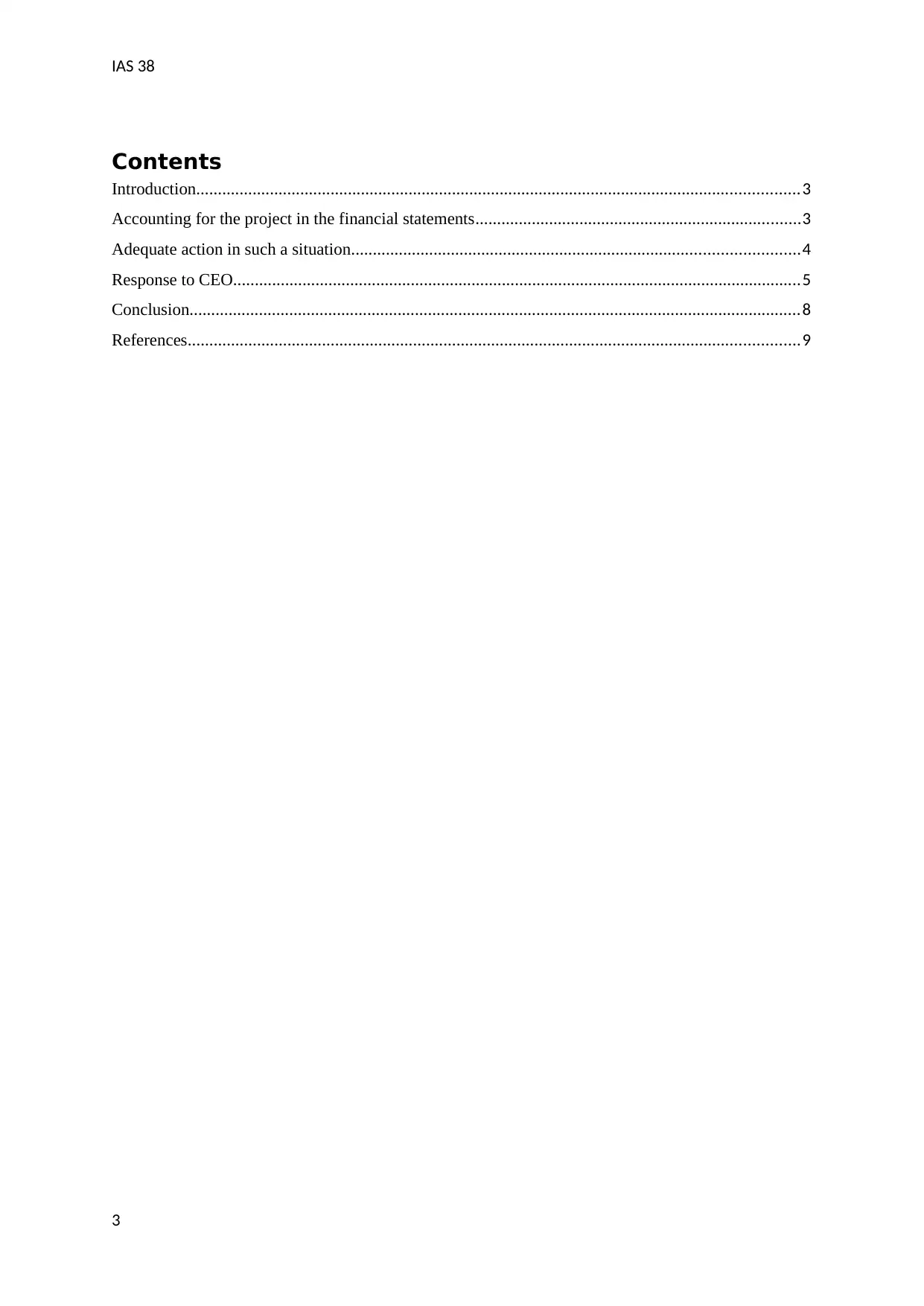
IAS 38
Contents
Introduction...........................................................................................................................................3
Accounting for the project in the financial statements...........................................................................3
Adequate action in such a situation.......................................................................................................4
Response to CEO...................................................................................................................................5
Conclusion.............................................................................................................................................8
References.............................................................................................................................................9
3
Contents
Introduction...........................................................................................................................................3
Accounting for the project in the financial statements...........................................................................3
Adequate action in such a situation.......................................................................................................4
Response to CEO...................................................................................................................................5
Conclusion.............................................................................................................................................8
References.............................................................................................................................................9
3
⊘ This is a preview!⊘
Do you want full access?
Subscribe today to unlock all pages.

Trusted by 1+ million students worldwide
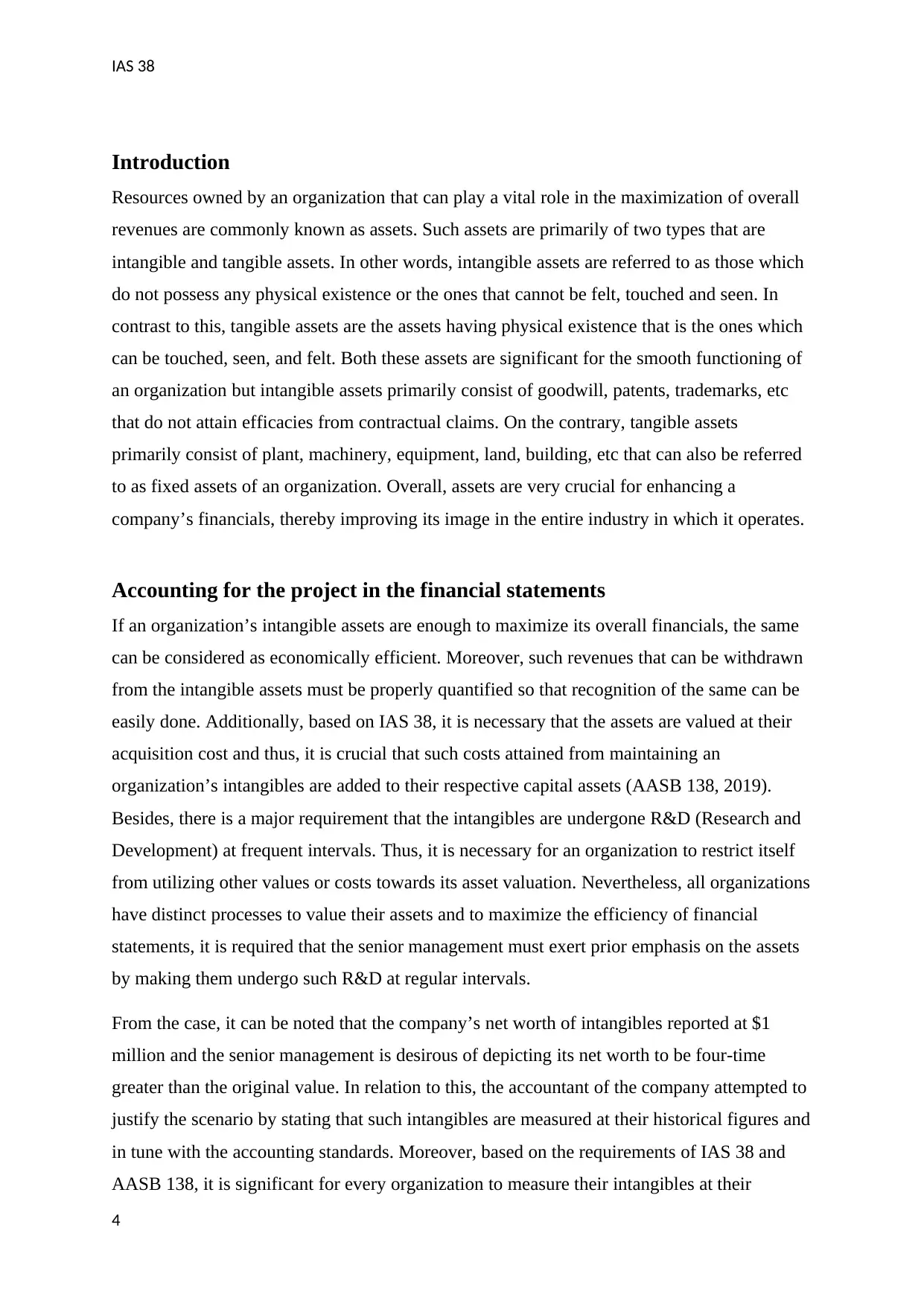
IAS 38
Introduction
Resources owned by an organization that can play a vital role in the maximization of overall
revenues are commonly known as assets. Such assets are primarily of two types that are
intangible and tangible assets. In other words, intangible assets are referred to as those which
do not possess any physical existence or the ones that cannot be felt, touched and seen. In
contrast to this, tangible assets are the assets having physical existence that is the ones which
can be touched, seen, and felt. Both these assets are significant for the smooth functioning of
an organization but intangible assets primarily consist of goodwill, patents, trademarks, etc
that do not attain efficacies from contractual claims. On the contrary, tangible assets
primarily consist of plant, machinery, equipment, land, building, etc that can also be referred
to as fixed assets of an organization. Overall, assets are very crucial for enhancing a
company’s financials, thereby improving its image in the entire industry in which it operates.
Accounting for the project in the financial statements
If an organization’s intangible assets are enough to maximize its overall financials, the same
can be considered as economically efficient. Moreover, such revenues that can be withdrawn
from the intangible assets must be properly quantified so that recognition of the same can be
easily done. Additionally, based on IAS 38, it is necessary that the assets are valued at their
acquisition cost and thus, it is crucial that such costs attained from maintaining an
organization’s intangibles are added to their respective capital assets (AASB 138, 2019).
Besides, there is a major requirement that the intangibles are undergone R&D (Research and
Development) at frequent intervals. Thus, it is necessary for an organization to restrict itself
from utilizing other values or costs towards its asset valuation. Nevertheless, all organizations
have distinct processes to value their assets and to maximize the efficiency of financial
statements, it is required that the senior management must exert prior emphasis on the assets
by making them undergo such R&D at regular intervals.
From the case, it can be noted that the company’s net worth of intangibles reported at $1
million and the senior management is desirous of depicting its net worth to be four-time
greater than the original value. In relation to this, the accountant of the company attempted to
justify the scenario by stating that such intangibles are measured at their historical figures and
in tune with the accounting standards. Moreover, based on the requirements of IAS 38 and
AASB 138, it is significant for every organization to measure their intangibles at their
4
Introduction
Resources owned by an organization that can play a vital role in the maximization of overall
revenues are commonly known as assets. Such assets are primarily of two types that are
intangible and tangible assets. In other words, intangible assets are referred to as those which
do not possess any physical existence or the ones that cannot be felt, touched and seen. In
contrast to this, tangible assets are the assets having physical existence that is the ones which
can be touched, seen, and felt. Both these assets are significant for the smooth functioning of
an organization but intangible assets primarily consist of goodwill, patents, trademarks, etc
that do not attain efficacies from contractual claims. On the contrary, tangible assets
primarily consist of plant, machinery, equipment, land, building, etc that can also be referred
to as fixed assets of an organization. Overall, assets are very crucial for enhancing a
company’s financials, thereby improving its image in the entire industry in which it operates.
Accounting for the project in the financial statements
If an organization’s intangible assets are enough to maximize its overall financials, the same
can be considered as economically efficient. Moreover, such revenues that can be withdrawn
from the intangible assets must be properly quantified so that recognition of the same can be
easily done. Additionally, based on IAS 38, it is necessary that the assets are valued at their
acquisition cost and thus, it is crucial that such costs attained from maintaining an
organization’s intangibles are added to their respective capital assets (AASB 138, 2019).
Besides, there is a major requirement that the intangibles are undergone R&D (Research and
Development) at frequent intervals. Thus, it is necessary for an organization to restrict itself
from utilizing other values or costs towards its asset valuation. Nevertheless, all organizations
have distinct processes to value their assets and to maximize the efficiency of financial
statements, it is required that the senior management must exert prior emphasis on the assets
by making them undergo such R&D at regular intervals.
From the case, it can be noted that the company’s net worth of intangibles reported at $1
million and the senior management is desirous of depicting its net worth to be four-time
greater than the original value. In relation to this, the accountant of the company attempted to
justify the scenario by stating that such intangibles are measured at their historical figures and
in tune with the accounting standards. Moreover, based on the requirements of IAS 38 and
AASB 138, it is significant for every organization to measure their intangibles at their
4
Paraphrase This Document
Need a fresh take? Get an instant paraphrase of this document with our AI Paraphraser
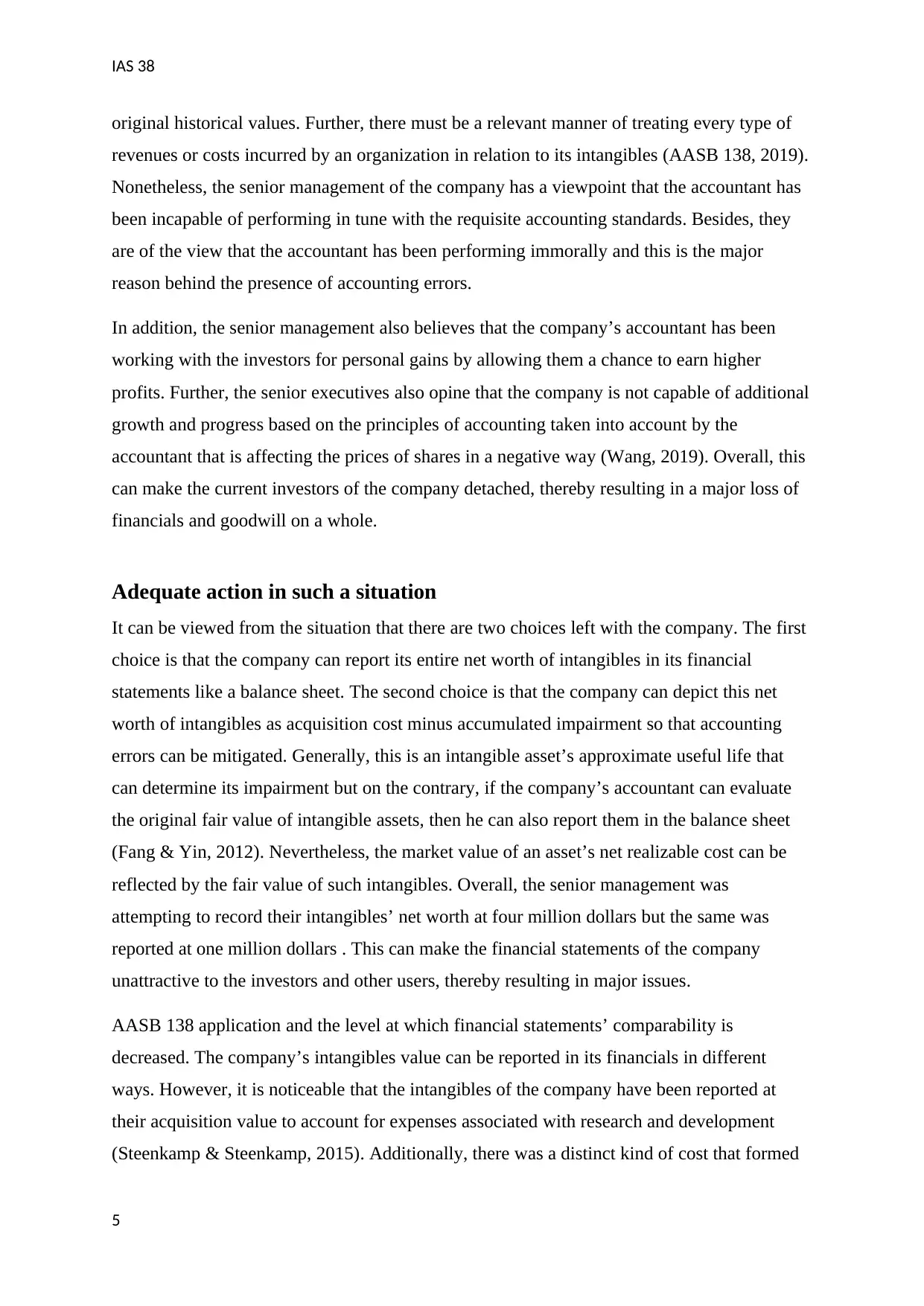
IAS 38
original historical values. Further, there must be a relevant manner of treating every type of
revenues or costs incurred by an organization in relation to its intangibles (AASB 138, 2019).
Nonetheless, the senior management of the company has a viewpoint that the accountant has
been incapable of performing in tune with the requisite accounting standards. Besides, they
are of the view that the accountant has been performing immorally and this is the major
reason behind the presence of accounting errors.
In addition, the senior management also believes that the company’s accountant has been
working with the investors for personal gains by allowing them a chance to earn higher
profits. Further, the senior executives also opine that the company is not capable of additional
growth and progress based on the principles of accounting taken into account by the
accountant that is affecting the prices of shares in a negative way (Wang, 2019). Overall, this
can make the current investors of the company detached, thereby resulting in a major loss of
financials and goodwill on a whole.
Adequate action in such a situation
It can be viewed from the situation that there are two choices left with the company. The first
choice is that the company can report its entire net worth of intangibles in its financial
statements like a balance sheet. The second choice is that the company can depict this net
worth of intangibles as acquisition cost minus accumulated impairment so that accounting
errors can be mitigated. Generally, this is an intangible asset’s approximate useful life that
can determine its impairment but on the contrary, if the company’s accountant can evaluate
the original fair value of intangible assets, then he can also report them in the balance sheet
(Fang & Yin, 2012). Nevertheless, the market value of an asset’s net realizable cost can be
reflected by the fair value of such intangibles. Overall, the senior management was
attempting to record their intangibles’ net worth at four million dollars but the same was
reported at one million dollars . This can make the financial statements of the company
unattractive to the investors and other users, thereby resulting in major issues.
AASB 138 application and the level at which financial statements’ comparability is
decreased. The company’s intangibles value can be reported in its financials in different
ways. However, it is noticeable that the intangibles of the company have been reported at
their acquisition value to account for expenses associated with research and development
(Steenkamp & Steenkamp, 2015). Additionally, there was a distinct kind of cost that formed
5
original historical values. Further, there must be a relevant manner of treating every type of
revenues or costs incurred by an organization in relation to its intangibles (AASB 138, 2019).
Nonetheless, the senior management of the company has a viewpoint that the accountant has
been incapable of performing in tune with the requisite accounting standards. Besides, they
are of the view that the accountant has been performing immorally and this is the major
reason behind the presence of accounting errors.
In addition, the senior management also believes that the company’s accountant has been
working with the investors for personal gains by allowing them a chance to earn higher
profits. Further, the senior executives also opine that the company is not capable of additional
growth and progress based on the principles of accounting taken into account by the
accountant that is affecting the prices of shares in a negative way (Wang, 2019). Overall, this
can make the current investors of the company detached, thereby resulting in a major loss of
financials and goodwill on a whole.
Adequate action in such a situation
It can be viewed from the situation that there are two choices left with the company. The first
choice is that the company can report its entire net worth of intangibles in its financial
statements like a balance sheet. The second choice is that the company can depict this net
worth of intangibles as acquisition cost minus accumulated impairment so that accounting
errors can be mitigated. Generally, this is an intangible asset’s approximate useful life that
can determine its impairment but on the contrary, if the company’s accountant can evaluate
the original fair value of intangible assets, then he can also report them in the balance sheet
(Fang & Yin, 2012). Nevertheless, the market value of an asset’s net realizable cost can be
reflected by the fair value of such intangibles. Overall, the senior management was
attempting to record their intangibles’ net worth at four million dollars but the same was
reported at one million dollars . This can make the financial statements of the company
unattractive to the investors and other users, thereby resulting in major issues.
AASB 138 application and the level at which financial statements’ comparability is
decreased. The company’s intangibles value can be reported in its financials in different
ways. However, it is noticeable that the intangibles of the company have been reported at
their acquisition value to account for expenses associated with research and development
(Steenkamp & Steenkamp, 2015). Additionally, there was a distinct kind of cost that formed
5
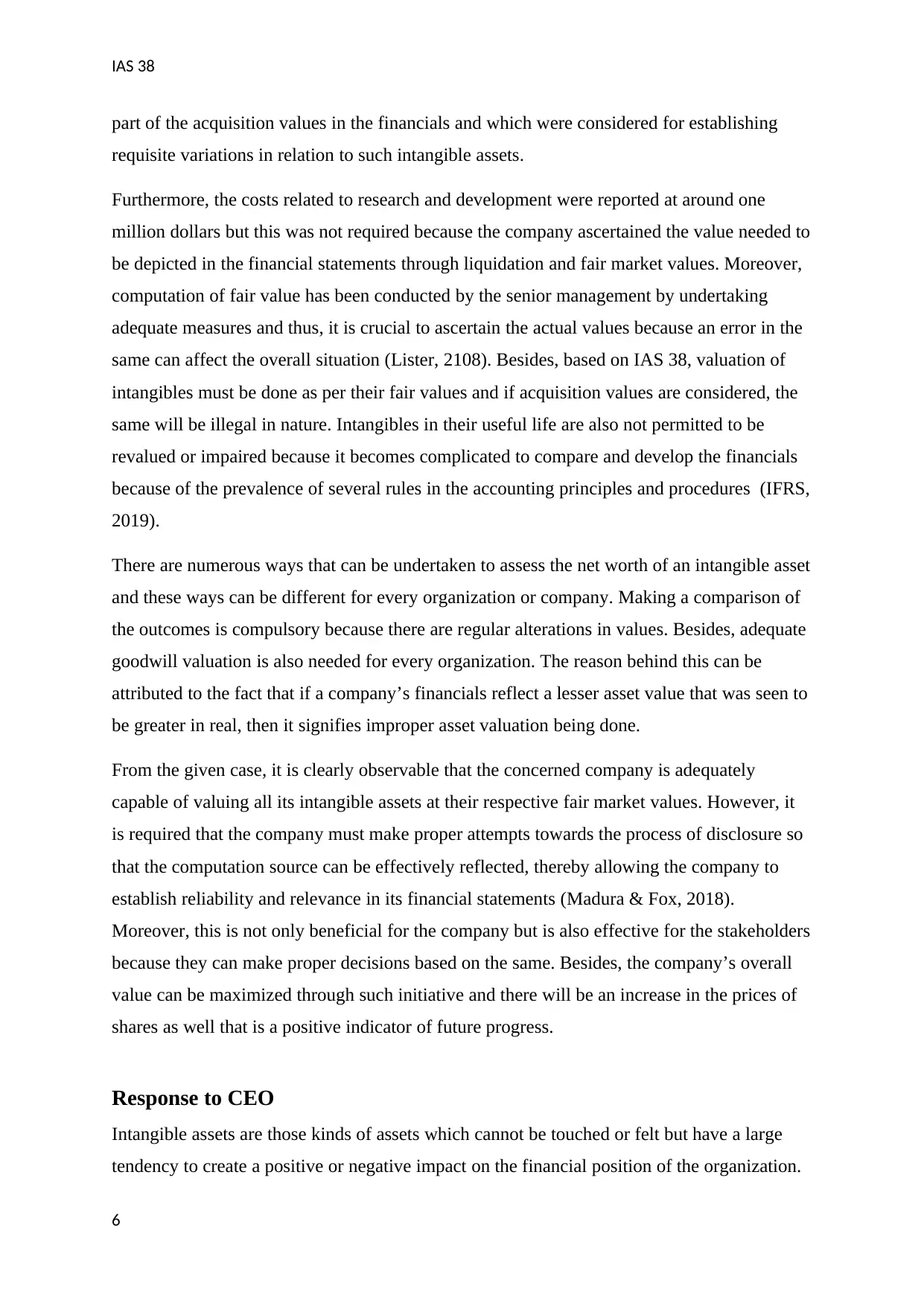
IAS 38
part of the acquisition values in the financials and which were considered for establishing
requisite variations in relation to such intangible assets.
Furthermore, the costs related to research and development were reported at around one
million dollars but this was not required because the company ascertained the value needed to
be depicted in the financial statements through liquidation and fair market values. Moreover,
computation of fair value has been conducted by the senior management by undertaking
adequate measures and thus, it is crucial to ascertain the actual values because an error in the
same can affect the overall situation (Lister, 2108). Besides, based on IAS 38, valuation of
intangibles must be done as per their fair values and if acquisition values are considered, the
same will be illegal in nature. Intangibles in their useful life are also not permitted to be
revalued or impaired because it becomes complicated to compare and develop the financials
because of the prevalence of several rules in the accounting principles and procedures (IFRS,
2019).
There are numerous ways that can be undertaken to assess the net worth of an intangible asset
and these ways can be different for every organization or company. Making a comparison of
the outcomes is compulsory because there are regular alterations in values. Besides, adequate
goodwill valuation is also needed for every organization. The reason behind this can be
attributed to the fact that if a company’s financials reflect a lesser asset value that was seen to
be greater in real, then it signifies improper asset valuation being done.
From the given case, it is clearly observable that the concerned company is adequately
capable of valuing all its intangible assets at their respective fair market values. However, it
is required that the company must make proper attempts towards the process of disclosure so
that the computation source can be effectively reflected, thereby allowing the company to
establish reliability and relevance in its financial statements (Madura & Fox, 2018).
Moreover, this is not only beneficial for the company but is also effective for the stakeholders
because they can make proper decisions based on the same. Besides, the company’s overall
value can be maximized through such initiative and there will be an increase in the prices of
shares as well that is a positive indicator of future progress.
Response to CEO
Intangible assets are those kinds of assets which cannot be touched or felt but have a large
tendency to create a positive or negative impact on the financial position of the organization.
6
part of the acquisition values in the financials and which were considered for establishing
requisite variations in relation to such intangible assets.
Furthermore, the costs related to research and development were reported at around one
million dollars but this was not required because the company ascertained the value needed to
be depicted in the financial statements through liquidation and fair market values. Moreover,
computation of fair value has been conducted by the senior management by undertaking
adequate measures and thus, it is crucial to ascertain the actual values because an error in the
same can affect the overall situation (Lister, 2108). Besides, based on IAS 38, valuation of
intangibles must be done as per their fair values and if acquisition values are considered, the
same will be illegal in nature. Intangibles in their useful life are also not permitted to be
revalued or impaired because it becomes complicated to compare and develop the financials
because of the prevalence of several rules in the accounting principles and procedures (IFRS,
2019).
There are numerous ways that can be undertaken to assess the net worth of an intangible asset
and these ways can be different for every organization or company. Making a comparison of
the outcomes is compulsory because there are regular alterations in values. Besides, adequate
goodwill valuation is also needed for every organization. The reason behind this can be
attributed to the fact that if a company’s financials reflect a lesser asset value that was seen to
be greater in real, then it signifies improper asset valuation being done.
From the given case, it is clearly observable that the concerned company is adequately
capable of valuing all its intangible assets at their respective fair market values. However, it
is required that the company must make proper attempts towards the process of disclosure so
that the computation source can be effectively reflected, thereby allowing the company to
establish reliability and relevance in its financial statements (Madura & Fox, 2018).
Moreover, this is not only beneficial for the company but is also effective for the stakeholders
because they can make proper decisions based on the same. Besides, the company’s overall
value can be maximized through such initiative and there will be an increase in the prices of
shares as well that is a positive indicator of future progress.
Response to CEO
Intangible assets are those kinds of assets which cannot be touched or felt but have a large
tendency to create a positive or negative impact on the financial position of the organization.
6
⊘ This is a preview!⊘
Do you want full access?
Subscribe today to unlock all pages.

Trusted by 1+ million students worldwide
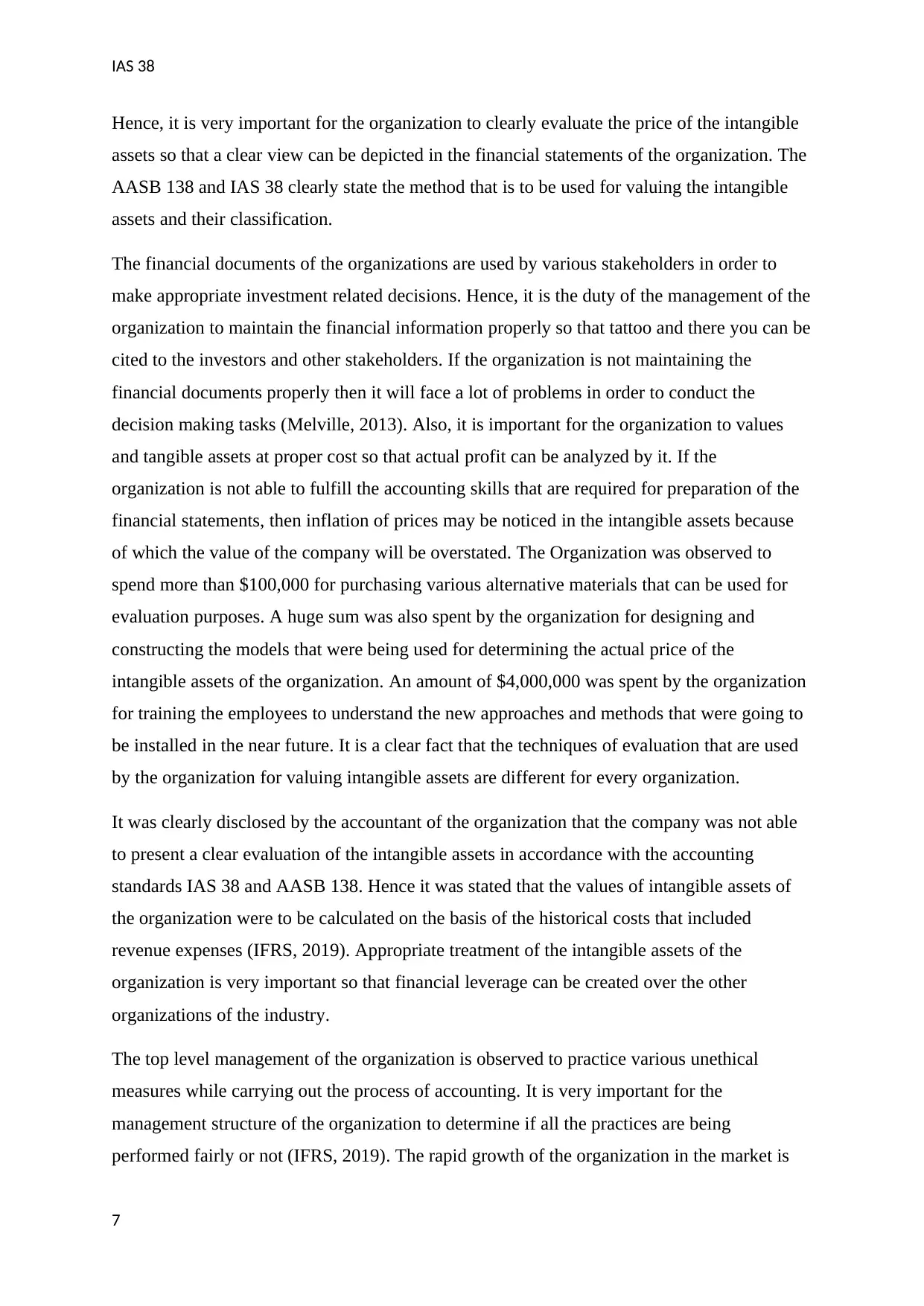
IAS 38
Hence, it is very important for the organization to clearly evaluate the price of the intangible
assets so that a clear view can be depicted in the financial statements of the organization. The
AASB 138 and IAS 38 clearly state the method that is to be used for valuing the intangible
assets and their classification.
The financial documents of the organizations are used by various stakeholders in order to
make appropriate investment related decisions. Hence, it is the duty of the management of the
organization to maintain the financial information properly so that tattoo and there you can be
cited to the investors and other stakeholders. If the organization is not maintaining the
financial documents properly then it will face a lot of problems in order to conduct the
decision making tasks (Melville, 2013). Also, it is important for the organization to values
and tangible assets at proper cost so that actual profit can be analyzed by it. If the
organization is not able to fulfill the accounting skills that are required for preparation of the
financial statements, then inflation of prices may be noticed in the intangible assets because
of which the value of the company will be overstated. The Organization was observed to
spend more than $100,000 for purchasing various alternative materials that can be used for
evaluation purposes. A huge sum was also spent by the organization for designing and
constructing the models that were being used for determining the actual price of the
intangible assets of the organization. An amount of $4,000,000 was spent by the organization
for training the employees to understand the new approaches and methods that were going to
be installed in the near future. It is a clear fact that the techniques of evaluation that are used
by the organization for valuing intangible assets are different for every organization.
It was clearly disclosed by the accountant of the organization that the company was not able
to present a clear evaluation of the intangible assets in accordance with the accounting
standards IAS 38 and AASB 138. Hence it was stated that the values of intangible assets of
the organization were to be calculated on the basis of the historical costs that included
revenue expenses (IFRS, 2019). Appropriate treatment of the intangible assets of the
organization is very important so that financial leverage can be created over the other
organizations of the industry.
The top level management of the organization is observed to practice various unethical
measures while carrying out the process of accounting. It is very important for the
management structure of the organization to determine if all the practices are being
performed fairly or not (IFRS, 2019). The rapid growth of the organization in the market is
7
Hence, it is very important for the organization to clearly evaluate the price of the intangible
assets so that a clear view can be depicted in the financial statements of the organization. The
AASB 138 and IAS 38 clearly state the method that is to be used for valuing the intangible
assets and their classification.
The financial documents of the organizations are used by various stakeholders in order to
make appropriate investment related decisions. Hence, it is the duty of the management of the
organization to maintain the financial information properly so that tattoo and there you can be
cited to the investors and other stakeholders. If the organization is not maintaining the
financial documents properly then it will face a lot of problems in order to conduct the
decision making tasks (Melville, 2013). Also, it is important for the organization to values
and tangible assets at proper cost so that actual profit can be analyzed by it. If the
organization is not able to fulfill the accounting skills that are required for preparation of the
financial statements, then inflation of prices may be noticed in the intangible assets because
of which the value of the company will be overstated. The Organization was observed to
spend more than $100,000 for purchasing various alternative materials that can be used for
evaluation purposes. A huge sum was also spent by the organization for designing and
constructing the models that were being used for determining the actual price of the
intangible assets of the organization. An amount of $4,000,000 was spent by the organization
for training the employees to understand the new approaches and methods that were going to
be installed in the near future. It is a clear fact that the techniques of evaluation that are used
by the organization for valuing intangible assets are different for every organization.
It was clearly disclosed by the accountant of the organization that the company was not able
to present a clear evaluation of the intangible assets in accordance with the accounting
standards IAS 38 and AASB 138. Hence it was stated that the values of intangible assets of
the organization were to be calculated on the basis of the historical costs that included
revenue expenses (IFRS, 2019). Appropriate treatment of the intangible assets of the
organization is very important so that financial leverage can be created over the other
organizations of the industry.
The top level management of the organization is observed to practice various unethical
measures while carrying out the process of accounting. It is very important for the
management structure of the organization to determine if all the practices are being
performed fairly or not (IFRS, 2019). The rapid growth of the organization in the market is
7
Paraphrase This Document
Need a fresh take? Get an instant paraphrase of this document with our AI Paraphraser
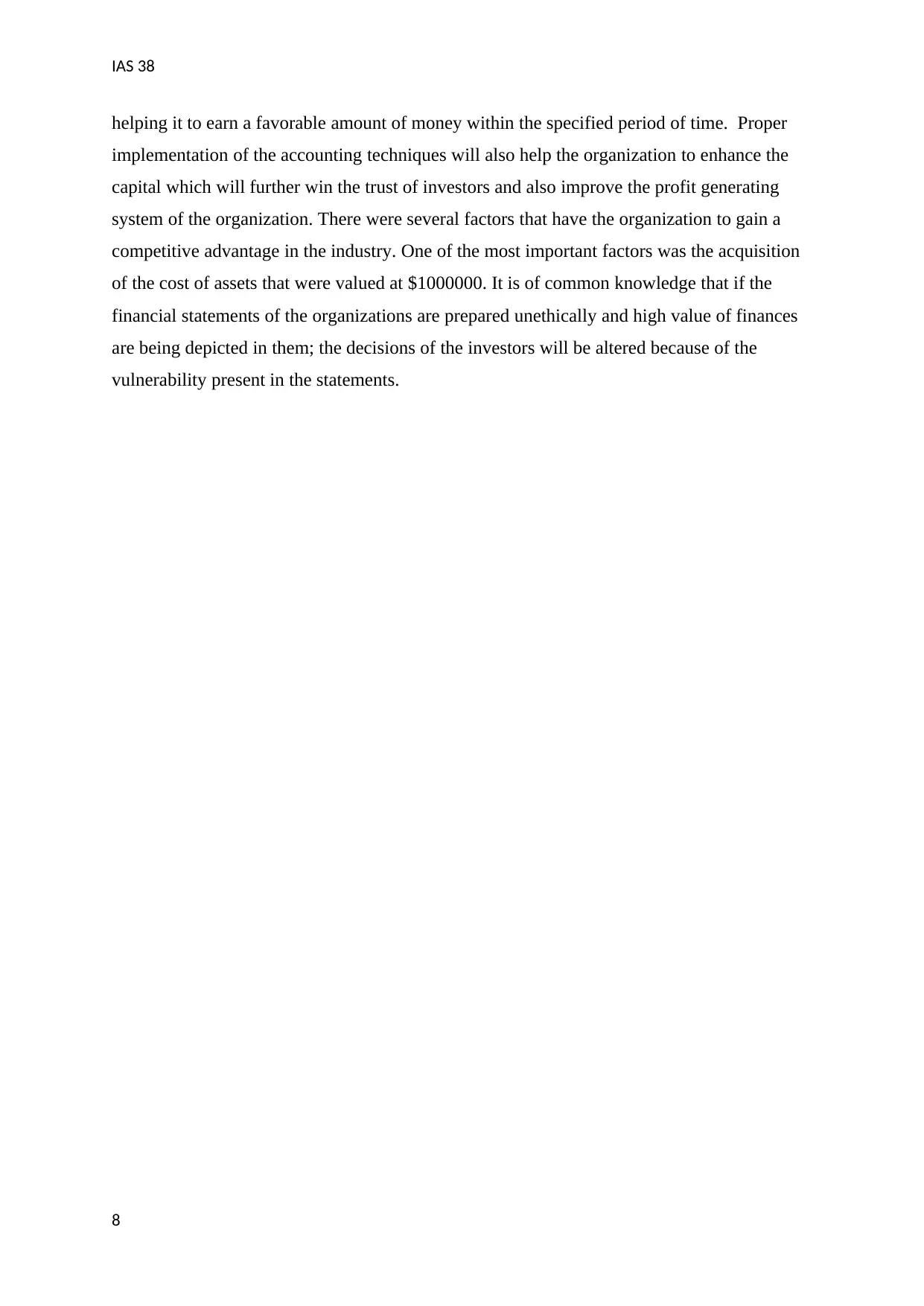
IAS 38
helping it to earn a favorable amount of money within the specified period of time. Proper
implementation of the accounting techniques will also help the organization to enhance the
capital which will further win the trust of investors and also improve the profit generating
system of the organization. There were several factors that have the organization to gain a
competitive advantage in the industry. One of the most important factors was the acquisition
of the cost of assets that were valued at $1000000. It is of common knowledge that if the
financial statements of the organizations are prepared unethically and high value of finances
are being depicted in them; the decisions of the investors will be altered because of the
vulnerability present in the statements.
8
helping it to earn a favorable amount of money within the specified period of time. Proper
implementation of the accounting techniques will also help the organization to enhance the
capital which will further win the trust of investors and also improve the profit generating
system of the organization. There were several factors that have the organization to gain a
competitive advantage in the industry. One of the most important factors was the acquisition
of the cost of assets that were valued at $1000000. It is of common knowledge that if the
financial statements of the organizations are prepared unethically and high value of finances
are being depicted in them; the decisions of the investors will be altered because of the
vulnerability present in the statements.
8
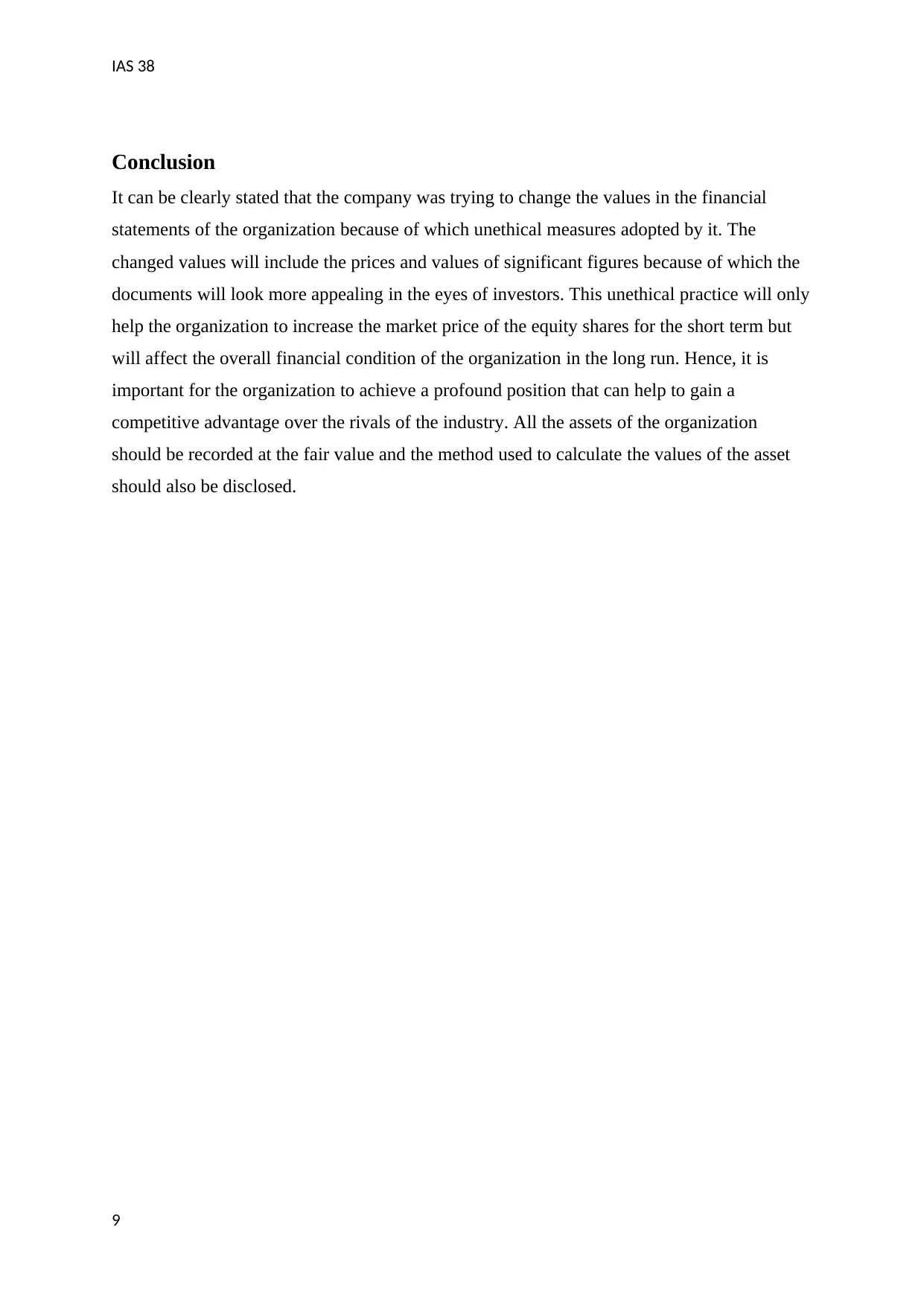
IAS 38
Conclusion
It can be clearly stated that the company was trying to change the values in the financial
statements of the organization because of which unethical measures adopted by it. The
changed values will include the prices and values of significant figures because of which the
documents will look more appealing in the eyes of investors. This unethical practice will only
help the organization to increase the market price of the equity shares for the short term but
will affect the overall financial condition of the organization in the long run. Hence, it is
important for the organization to achieve a profound position that can help to gain a
competitive advantage over the rivals of the industry. All the assets of the organization
should be recorded at the fair value and the method used to calculate the values of the asset
should also be disclosed.
9
Conclusion
It can be clearly stated that the company was trying to change the values in the financial
statements of the organization because of which unethical measures adopted by it. The
changed values will include the prices and values of significant figures because of which the
documents will look more appealing in the eyes of investors. This unethical practice will only
help the organization to increase the market price of the equity shares for the short term but
will affect the overall financial condition of the organization in the long run. Hence, it is
important for the organization to achieve a profound position that can help to gain a
competitive advantage over the rivals of the industry. All the assets of the organization
should be recorded at the fair value and the method used to calculate the values of the asset
should also be disclosed.
9
⊘ This is a preview!⊘
Do you want full access?
Subscribe today to unlock all pages.

Trusted by 1+ million students worldwide
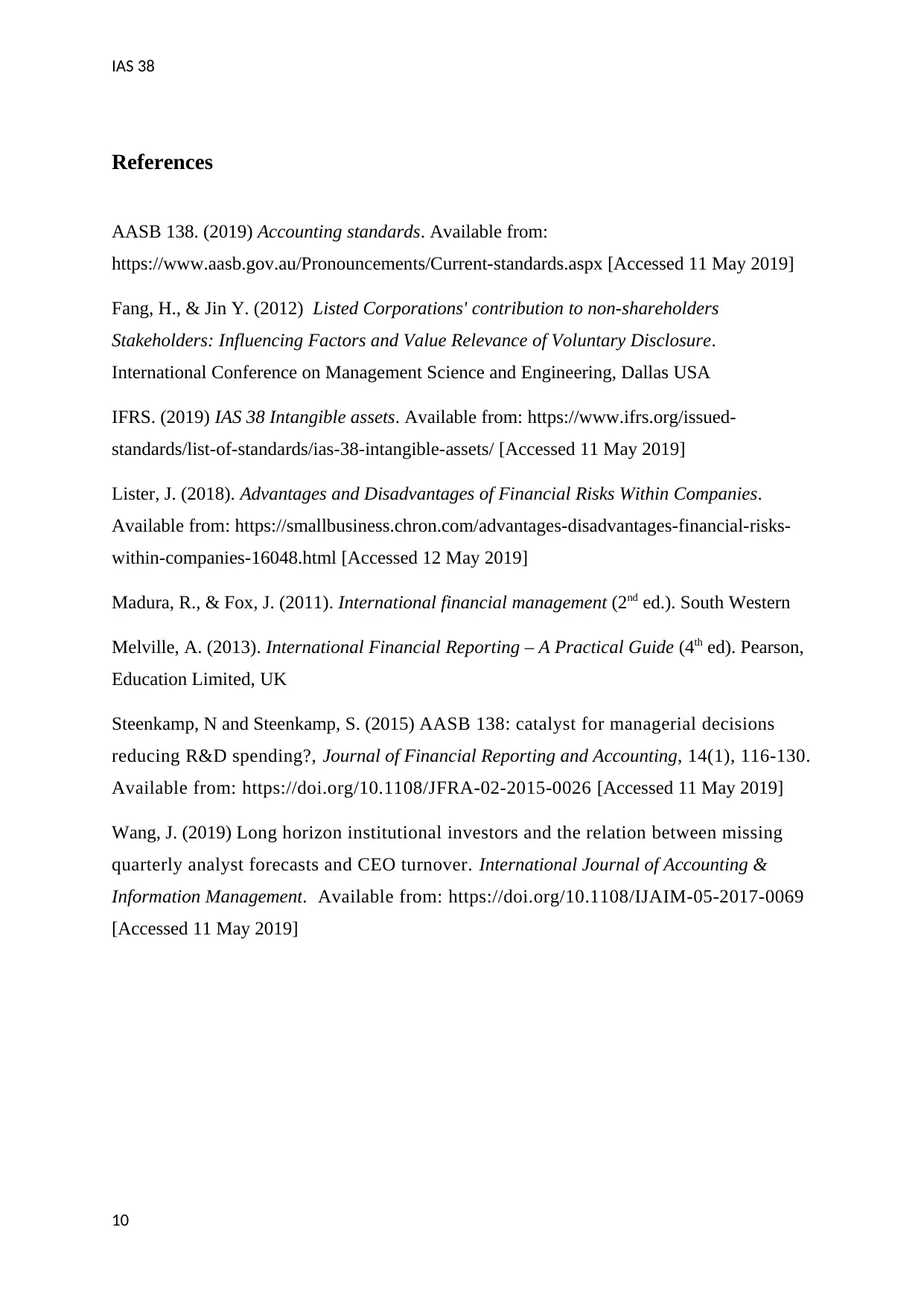
IAS 38
References
AASB 138. (2019) Accounting standards. Available from:
https://www.aasb.gov.au/Pronouncements/Current-standards.aspx [Accessed 11 May 2019]
Fang, H., & Jin Y. (2012) Listed Corporations' contribution to non-shareholders
Stakeholders: Influencing Factors and Value Relevance of Voluntary Disclosure.
International Conference on Management Science and Engineering, Dallas USA
IFRS. (2019) IAS 38 Intangible assets. Available from: https://www.ifrs.org/issued-
standards/list-of-standards/ias-38-intangible-assets/ [Accessed 11 May 2019]
Lister, J. (2018). Advantages and Disadvantages of Financial Risks Within Companies.
Available from: https://smallbusiness.chron.com/advantages-disadvantages-financial-risks-
within-companies-16048.html [Accessed 12 May 2019]
Madura, R., & Fox, J. (2011). International financial management (2nd ed.). South Western
Melville, A. (2013). International Financial Reporting – A Practical Guide (4th ed). Pearson,
Education Limited, UK
Steenkamp, N and Steenkamp, S. (2015) AASB 138: catalyst for managerial decisions
reducing R&D spending?, Journal of Financial Reporting and Accounting, 14(1), 116-130.
Available from: https://doi.org/10.1108/JFRA-02-2015-0026 [Accessed 11 May 2019]
Wang, J. (2019) Long horizon institutional investors and the relation between missing
quarterly analyst forecasts and CEO turnover. International Journal of Accounting &
Information Management. Available from: https://doi.org/10.1108/IJAIM-05-2017-0069
[Accessed 11 May 2019]
10
References
AASB 138. (2019) Accounting standards. Available from:
https://www.aasb.gov.au/Pronouncements/Current-standards.aspx [Accessed 11 May 2019]
Fang, H., & Jin Y. (2012) Listed Corporations' contribution to non-shareholders
Stakeholders: Influencing Factors and Value Relevance of Voluntary Disclosure.
International Conference on Management Science and Engineering, Dallas USA
IFRS. (2019) IAS 38 Intangible assets. Available from: https://www.ifrs.org/issued-
standards/list-of-standards/ias-38-intangible-assets/ [Accessed 11 May 2019]
Lister, J. (2018). Advantages and Disadvantages of Financial Risks Within Companies.
Available from: https://smallbusiness.chron.com/advantages-disadvantages-financial-risks-
within-companies-16048.html [Accessed 12 May 2019]
Madura, R., & Fox, J. (2011). International financial management (2nd ed.). South Western
Melville, A. (2013). International Financial Reporting – A Practical Guide (4th ed). Pearson,
Education Limited, UK
Steenkamp, N and Steenkamp, S. (2015) AASB 138: catalyst for managerial decisions
reducing R&D spending?, Journal of Financial Reporting and Accounting, 14(1), 116-130.
Available from: https://doi.org/10.1108/JFRA-02-2015-0026 [Accessed 11 May 2019]
Wang, J. (2019) Long horizon institutional investors and the relation between missing
quarterly analyst forecasts and CEO turnover. International Journal of Accounting &
Information Management. Available from: https://doi.org/10.1108/IJAIM-05-2017-0069
[Accessed 11 May 2019]
10
1 out of 10
Related Documents
Your All-in-One AI-Powered Toolkit for Academic Success.
+13062052269
info@desklib.com
Available 24*7 on WhatsApp / Email
![[object Object]](/_next/static/media/star-bottom.7253800d.svg)
Unlock your academic potential
Copyright © 2020–2025 A2Z Services. All Rights Reserved. Developed and managed by ZUCOL.





